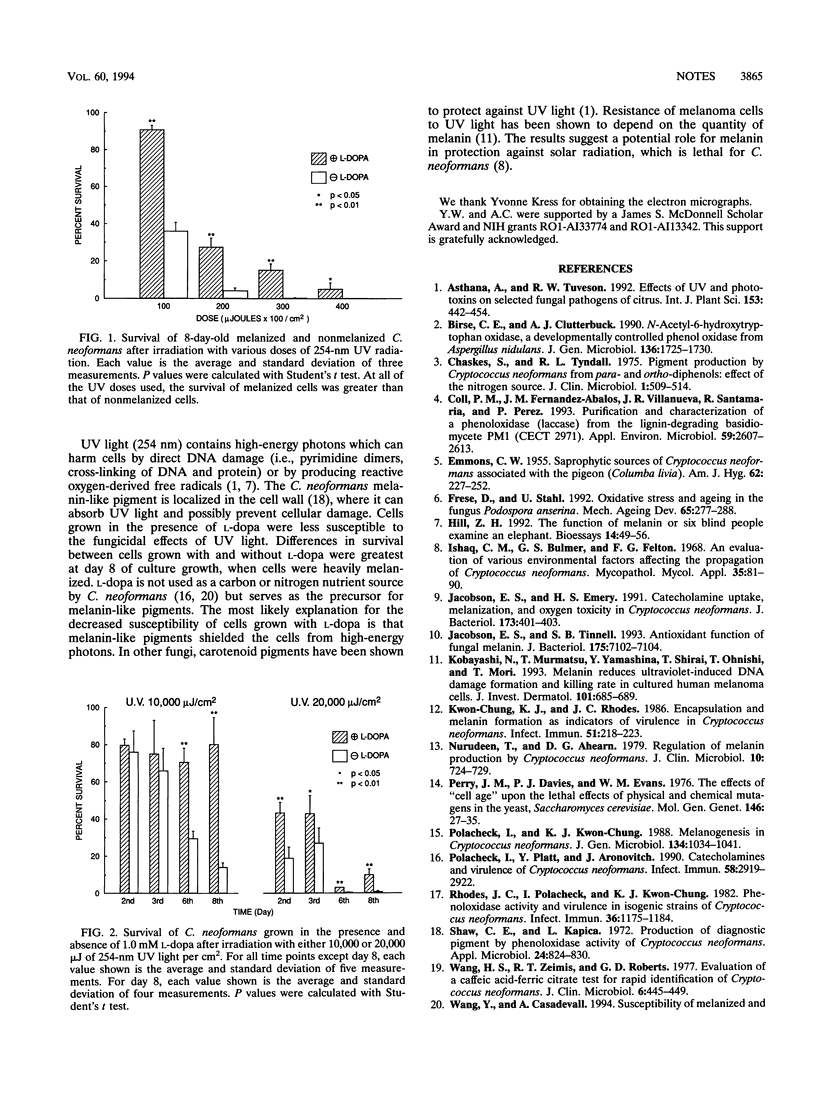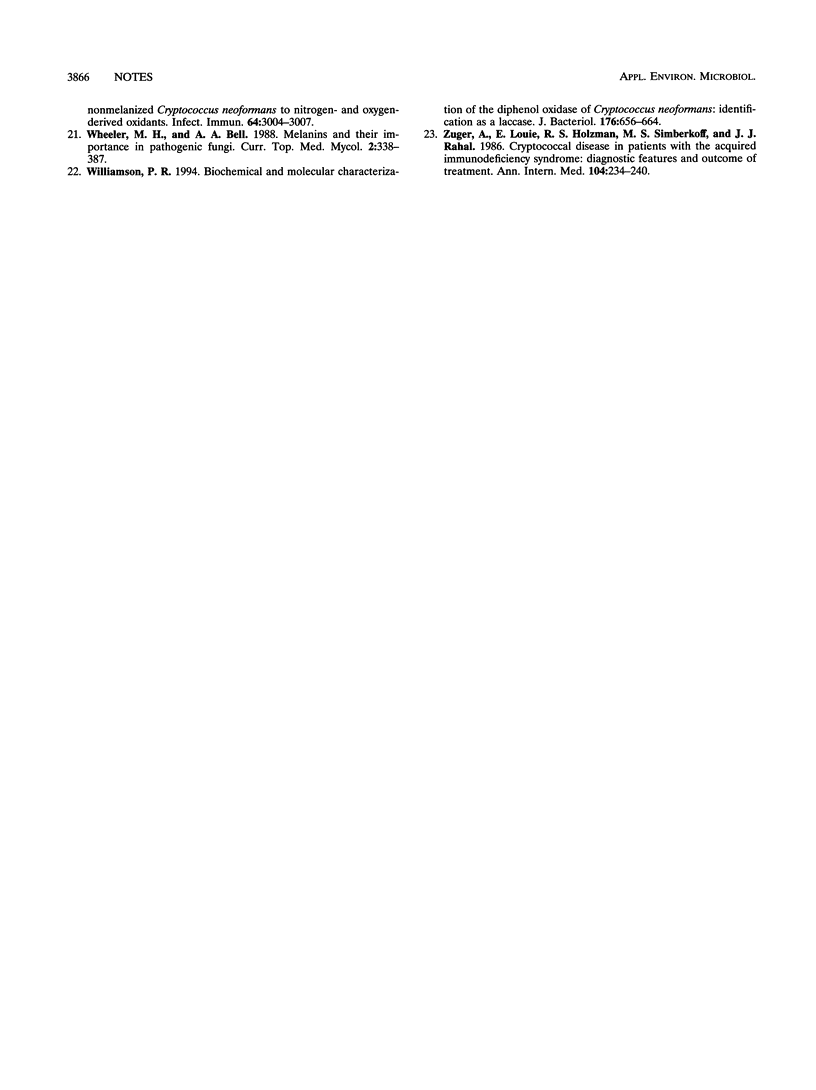Abstract
Melanized Cryptococcus neoformans cells were less susceptible than nonmelanized cells to the fungicidal effects of UV light. Phenoloxidase-catalyzed production of melanin-like pigments may serve to protect the fungus against ionizing radiation.
Full text
PDF


Selected References
These references are in PubMed. This may not be the complete list of references from this article.
- Birse C. E., Clutterbuck A. J. N-acetyl-6-hydroxytryptophan oxidase, a developmentally controlled phenol oxidase from Aspergillus nidulans. J Gen Microbiol. 1990 Sep;136(9):1725–1730. doi: 10.1099/00221287-136-9-1725. [DOI] [PubMed] [Google Scholar]
- Chaskes S., Tyndall R. L. Pigment production by Cryptococcus neoformans from para- and ortho-Diphenols: effect of the nitrogen source. J Clin Microbiol. 1975 Jun;1(6):509–514. doi: 10.1128/jcm.1.6.509-514.1975. [DOI] [PMC free article] [PubMed] [Google Scholar]
- Coll P. M., Fernández-Abalos J. M., Villanueva J. R., Santamaría R., Pérez P. Purification and characterization of a phenoloxidase (laccase) from the lignin-degrading basidiomycete PM1 (CECT 2971). Appl Environ Microbiol. 1993 Aug;59(8):2607–2613. doi: 10.1128/aem.59.8.2607-2613.1993. [DOI] [PMC free article] [PubMed] [Google Scholar]
- EMMONS C. W. Saprophytic sources of Cryptococcus neoformans associated with the pigeon (Columba livia). Am J Hyg. 1955 Nov;62(3):227–232. doi: 10.1093/oxfordjournals.aje.a119775. [DOI] [PubMed] [Google Scholar]
- Frese D., Stahl U. Oxidative stress and ageing in the fungus Podospora anserina. Mech Ageing Dev. 1992 Sep;65(2-3):277–288. doi: 10.1016/0047-6374(92)90041-b. [DOI] [PubMed] [Google Scholar]
- Hill H. Z. The function of melanin or six blind people examine an elephant. Bioessays. 1992 Jan;14(1):49–56. doi: 10.1002/bies.950140111. [DOI] [PubMed] [Google Scholar]
- Ishaq C. M., Bulmer G. S., Felton F. G. An evaluation of various environmental factors affecting the propagation of Cryptococcus neoformas. Mycopathol Mycol Appl. 1968 Jul 12;35(2):81–90. doi: 10.1007/BF02049570. [DOI] [PubMed] [Google Scholar]
- Jacobson E. S., Emery H. S. Catecholamine uptake, melanization, and oxygen toxicity in Cryptococcus neoformans. J Bacteriol. 1991 Jan;173(1):401–403. doi: 10.1128/jb.173.1.401-403.1991. [DOI] [PMC free article] [PubMed] [Google Scholar]
- Jacobson E. S., Tinnell S. B. Antioxidant function of fungal melanin. J Bacteriol. 1993 Nov;175(21):7102–7104. doi: 10.1128/jb.175.21.7102-7104.1993. [DOI] [PMC free article] [PubMed] [Google Scholar]
- Kobayashi N., Muramatsu T., Yamashina Y., Shirai T., Ohnishi T., Mori T. Melanin reduces ultraviolet-induced DNA damage formation and killing rate in cultured human melanoma cells. J Invest Dermatol. 1993 Nov;101(5):685–689. doi: 10.1111/1523-1747.ep12371676. [DOI] [PubMed] [Google Scholar]
- Kwon-Chung K. J., Rhodes J. C. Encapsulation and melanin formation as indicators of virulence in Cryptococcus neoformans. Infect Immun. 1986 Jan;51(1):218–223. doi: 10.1128/iai.51.1.218-223.1986. [DOI] [PMC free article] [PubMed] [Google Scholar]
- Nurudeen T. A., Ahearn D. G. Regulation of melanin production by Cryptococcus neoformans. J Clin Microbiol. 1979 Nov;10(5):724–729. doi: 10.1128/jcm.10.5.724-729.1979. [DOI] [PMC free article] [PubMed] [Google Scholar]
- Parry J. M., Davies P. J., Evans W. E. The effects of "cell age" upon the lethal effects of physical and chemical mutagens in the yeast, Saccharomyces cerevisiae. Mol Gen Genet. 1976 Jul 5;146(1):27–35. doi: 10.1007/BF00267979. [DOI] [PubMed] [Google Scholar]
- Polacheck I., Kwon-Chung K. J. Melanogenesis in Cryptococcus neoformans. J Gen Microbiol. 1988 Apr;134(4):1037–1041. doi: 10.1099/00221287-134-4-1037. [DOI] [PubMed] [Google Scholar]
- Polacheck I., Platt Y., Aronovitch J. Catecholamines and virulence of Cryptococcus neoformans. Infect Immun. 1990 Sep;58(9):2919–2922. doi: 10.1128/iai.58.9.2919-2922.1990. [DOI] [PMC free article] [PubMed] [Google Scholar]
- Rhodes J. C., Polacheck I., Kwon-Chung K. J. Phenoloxidase activity and virulence in isogenic strains of Cryptococcus neoformans. Infect Immun. 1982 Jun;36(3):1175–1184. doi: 10.1128/iai.36.3.1175-1184.1982. [DOI] [PMC free article] [PubMed] [Google Scholar]
- Shaw C. E., Kapica L. Production of diagnostic pigment by phenoloxidase activity of cryptococcus neoformans. Appl Microbiol. 1972 Nov;24(5):824–830. doi: 10.1128/am.24.5.824-830.1972. [DOI] [PMC free article] [PubMed] [Google Scholar]
- Wang H. S., Zeimis R. T., Roberts G. D. Evaluation of a caffeic acid-ferric citrate test for rapid identification of Cryptococcus neoformans. J Clin Microbiol. 1977 Nov;6(5):445–449. doi: 10.1128/jcm.6.5.445-449.1977. [DOI] [PMC free article] [PubMed] [Google Scholar]
- Wheeler M. H., Bell A. A. Melanins and their importance in pathogenic fungi. Curr Top Med Mycol. 1988;2:338–387. doi: 10.1007/978-1-4612-3730-3_10. [DOI] [PubMed] [Google Scholar]
- Williamson P. R. Biochemical and molecular characterization of the diphenol oxidase of Cryptococcus neoformans: identification as a laccase. J Bacteriol. 1994 Feb;176(3):656–664. doi: 10.1128/jb.176.3.656-664.1994. [DOI] [PMC free article] [PubMed] [Google Scholar]
- Zuger A., Louie E., Holzman R. S., Simberkoff M. S., Rahal J. J. Cryptococcal disease in patients with the acquired immunodeficiency syndrome. Diagnostic features and outcome of treatment. Ann Intern Med. 1986 Feb;104(2):234–240. doi: 10.7326/0003-4819-104-2-234. [DOI] [PubMed] [Google Scholar]


